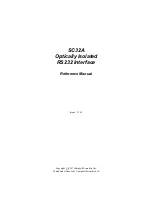
SC32A Optically Isolated RS232 Interface
2
3.2 9-Pin
The SC32A 9-pin male port connects to the datalogger through the SC12 Two
Peripheral Cable supplied with the SC32A.
Table 1 gives pin descriptions for both the SC32A connectors.
Table 1 SC32A Connector Descriptions
25-Pin Female Connector
9-Pin Male Connector
Pin #I/O
Description
Pin #
I/O
Description
1
GROUND
1
IN
+5V
2
IN
TX
2
GROUND
3
OUT
RX
3
OUT
RING
4
IN
RTS (POWER)
4
OUT
RX
5
OUT
CTS
5
IN
ME
6
OUT
DSR
6
IN
PE (CR10 SDE)
7
GROUND
9
IN
TX
8
OUT
DCD
15
IN
SPECIAL POWER
20
IN
DTR (POWER)
4. Operation
Power for the datalogger section of the SC32A comes from the 5V supply on pin
1 of the datalogger I/O port. Communication logic levels to and from the data-
logger are referenced to this voltage, ranging from 0 to slightly less than 5V.
Power for the RS232 section is taken from the Data Terminal Ready (DTR) and
Request To Send (RTS) lines of the RS232 peripheral. An on-board DC to DC
converter supplies the negative voltage required for RS232 signals. The logic
levels from the SC32A to the RS232 peripheral are 0.6V less than the supply
voltage. For example, if the DTR line supplies 9V to the SC32A, logic levels of
± 8.4V are returned. If the peripheral requires logic levels greater than the voltage
provided by the DTR and RTS voltages, an external supply may be used to power
the RS232 side of the SC32A (see Section 5).
When the SC32A first receives a character from the peripheral (pin 2), 5V is
applied to the datalogger Ring line (pin 3) for one second or until the datalogger
Modem Enable (ME) goes high, putting the datalogger into the Telecommuni-
cations Mode.
RS232 cables of up to 60m have been used successfully between the SC32A and
an IBM PC at 9600 baud. The length of cable that can be used is largely depend-
ent on the RS232 DTR and RTS drive capability as well as the RS232 RX
operating thresholds. A good quality screened cable should be used for long runs.
5. Application
The 21X and CR7 dataloggers communicate with a peripheral by enabling it with
an assigned I/O pin. The CR10 can use this enabling system, but also supports a
synchronous addressing scheme to select peripherals. The addressing system
allows up to 16 peripherals to be selected for communication, whereas the pin-
enable system is limited by the number of pins available for the enabling task
(three). Correct use of the SC32A not only depends on the datalogger type but
also, for the CR10, how the peripheral is activated (pin-enabled or address-
selected) and how many peripherals are present.
Содержание SC32A
Страница 2: ......
Страница 4: ......
Страница 6: ......
Страница 12: ...SC32A Optically Isolated RS232 Interface 6 Figure 2 Schematic...






























